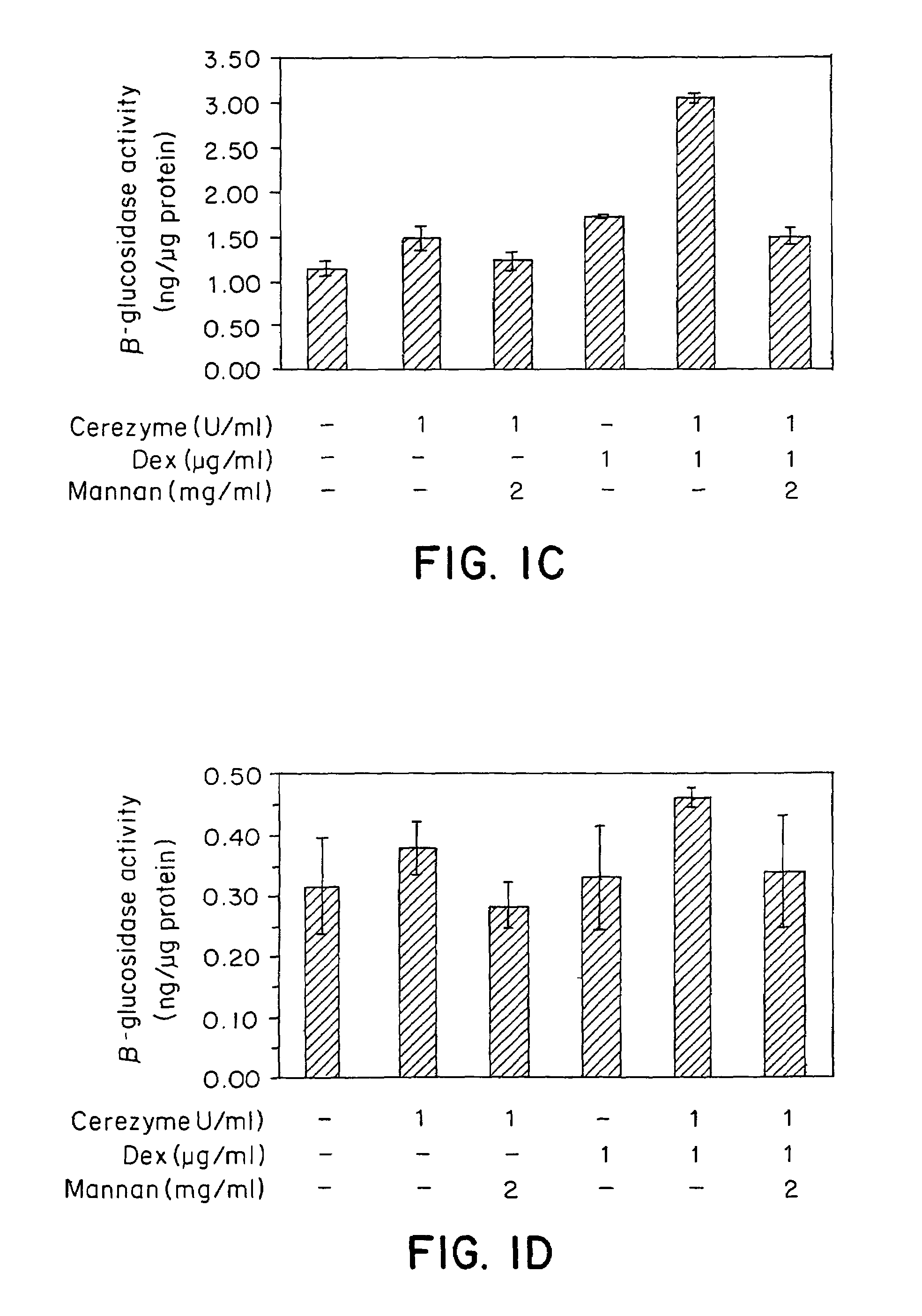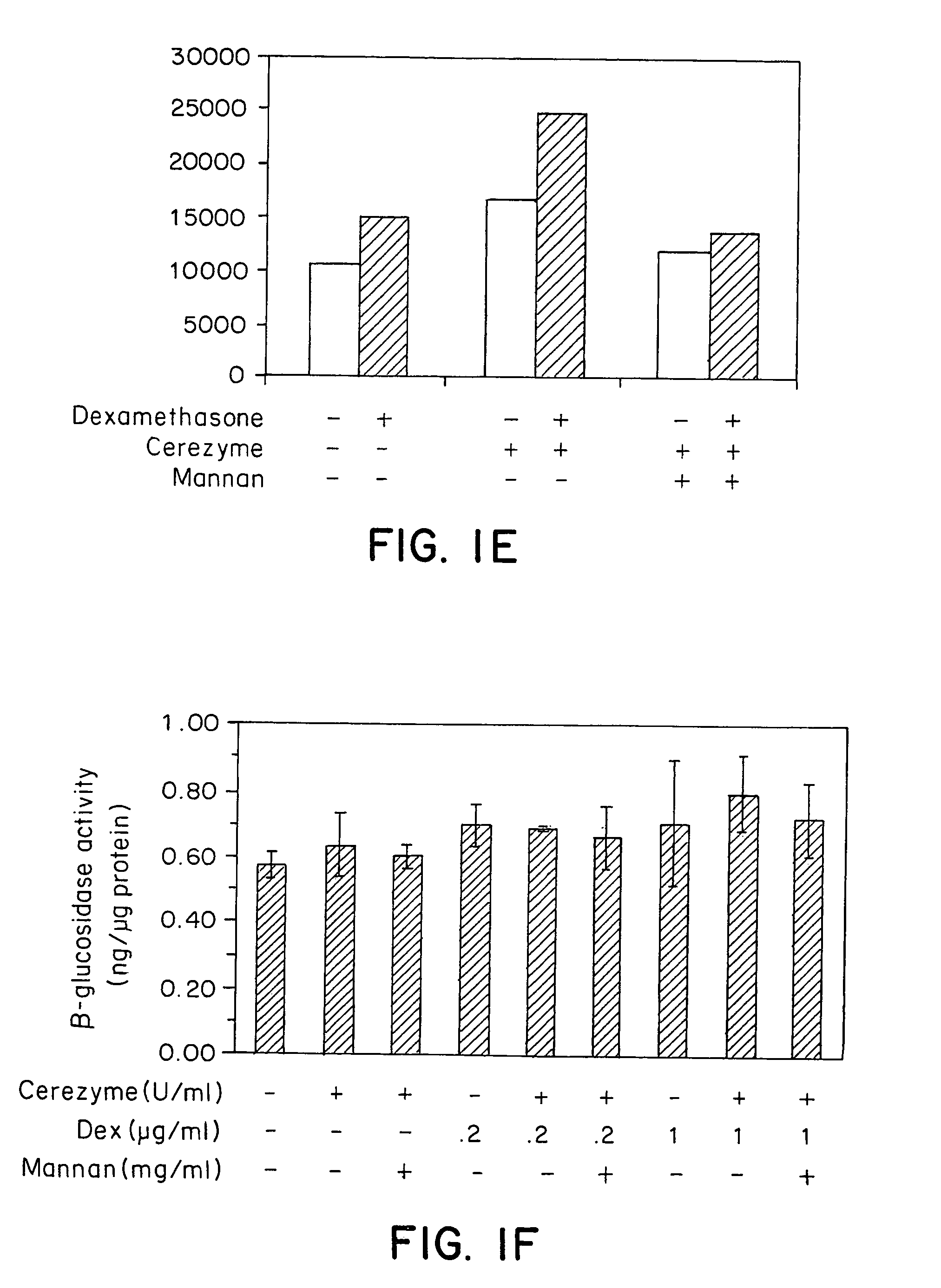Methods of enhancing lysosomal storage disease therapy by modulation of cell surface receptor density
a cell surface receptor and lysosomal storage technology, applied in drug compositions, peptides, metabolic disorders, etc., can solve the problem of rapid removal of infused lysosomal enzymes from the blood, increase the uptake of extracellular lysosomal enzymes by cells, and increase the uptake of acid alpha glucosidase by the target organ
- Summary
- Abstract
- Description
- Claims
- Application Information
AI Technical Summary
Benefits of technology
Problems solved by technology
Method used
Image
Examples
example 1
Dexamethasone Increases Uptake of CEREZYME® Enzyme by Liver Macrophage Cells In Vitro
[0102]Three representative cell types of the liver were assayed for CEREZYME® enzyme uptake under the influence of dexamethasone. An alveolar macrophage cell line was used to represent liver Kupffer cells, Hep3B cells were used to represent hepatocytes and liver sinusoidal endothelial cells (LSECs) were primary cells derived from the human liver.
[0103]The rat alveolar macrophage cell line NR 8383 (ATCC# CRL-2192) were cultured in Kaighn's modified F12K nutrient mixture (Gibco# 21127-002) with 2 mM L-glutamine (Gibco# 25030-081), 15% heat-inactivated fetal bovine serum (FBS) (Gibco# 16000-044) and 1× penicillin / streptomycin. Most of the cells were attached to the dish, with some in suspension. Hep3B cells were grown in MEM-eagle (Gibco# 11960-044) with Earles salts and 10% FBS, 1× non-essential amino acid (NEAA), 1× sodium pyruvate and 1× penicillin / streptomycin. Human liver sinusoidal endothelial ce...
example 2
Dexamethasone Pretreatment Increases Uptake of CEREZYME® Enzyme by Tissue Macrophage Cells In Vivo
[0110]To assess the effect of dexamethasone treatment on CEREZYME® enzyme uptake by liver macrophage (Kupffer cells) in vivo, Fisher rats (female, ˜130 g) were divided into four groups (n=3). The first and second groups of rats only received vehicle PBS without dexamethasone, and the third and fourth groups were treated with water-soluble dexamethasone sodium phosphate (American Reagent Laboratories Inc.) at 10 μg and 100 μg (diluted into 200 μl PBS) per rat through intraperitoneal injection. Four doses of dexamethasone were given over two consecutive days, one dose in early morning and one dose in late afternoon on each day. On the third day, CEREZYME® enzyme at 2.5 U per rat (˜18 U / kg) diluted in PBS was administrated into the second, third and fourth groups of rats through tail vein bolus injection. The first group was used as negative control.
[0111]Two hours after CEREZYME® enzyme i...
example 3
Insulin / Glucose Increases Alpha-galactosidase Uptake by Cells In Vitro
[0118]Muscles are the major target tissues for enzyme replacement therapy of Pompe disease due to the lack of acid alpha-glucosidase. To determine if the M6P / IGF-II receptor-mediated lysosomal enzyme uptake pathway can be augmented by insulin / glucose, the effects of insulin / glucose were analyzed on induced muscle cells (myotubes) in vitro. L6 myoblasts (or induced myotubes) and Hep3B cells were cultured in 6-well dishes. Rat L6 myoblasts (ATCC# CRL-1458) were cultured at 37° C. under 5% CO2 in VitaCell DMEM media (ATCC# 30-2002) with 4 mM L-glutamine, 10% fetal bovine serum (Gibco #16000-044) and 1× penicillin / streptomycin. Once confluent, cells were switched to VitaCell DMEM plus 2% horse sera (Gibco# 26050-088) and 1× penicillin / streptomycin. Media were changed every 3 days and at day 9-10, myotubes could be observed as multinuclear tubes. About 30-40% of the myoblasts formed myotubes. Cells were used for uptake...
PUM
| Property | Measurement | Unit |
|---|---|---|
| Time | aaaaa | aaaaa |
| Density | aaaaa | aaaaa |
Abstract
Description
Claims
Application Information
 Login to View More
Login to View More - R&D
- Intellectual Property
- Life Sciences
- Materials
- Tech Scout
- Unparalleled Data Quality
- Higher Quality Content
- 60% Fewer Hallucinations
Browse by: Latest US Patents, China's latest patents, Technical Efficacy Thesaurus, Application Domain, Technology Topic, Popular Technical Reports.
© 2025 PatSnap. All rights reserved.Legal|Privacy policy|Modern Slavery Act Transparency Statement|Sitemap|About US| Contact US: help@patsnap.com



